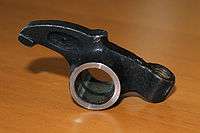Rocker arm
A rocker arm (in the context of an internal combustion engine of automotive, marine, motorcycle and reciprocating aviation types) is an oscillating lever that conveys radial movement from the cam lobe into linear movement at the poppet valve to open it. One end is raised and lowered by a rotating lobe of the camshaft (either directly or via a tappet (lifter) and pushrod) while the other end acts on the valve stem. When the camshaft lobe raises the outside of the arm, the inside presses down on the valve stem, opening the valve. When the outside of the arm is permitted to return due to the camshafts rotation, the inside rises, allowing the valve spring to close the valve.

Some overhead cam engines employ short rocker arms in which the cam lobe pushes down (rather than up) on the rocker arm to open the valve. On this type of rocker arm, the fulcrum is at the end rather than the middle, while the cam acts on the middle of the arm. The opposite end opens the valve. These types of rocker arms are particularly common on dual overhead cam motors, and are often used instead of direct tappets.
Overview
The drive cam is driven by the camshaft. This pushes the rocker arm up and down about the trunnion pin or rocker shaft. Friction may be reduced at the point of contact with the valve stem by a roller tip. A similar arrangement transfers the motion via another roller tip to a second rocker arm. This rotates about the rocker shaft, and transfers the motion via a tappet to the poppet valve. In this case this opens the intake valve to the cylinder head.
A roller rocker is a rocker arm that uses bearings instead of metal sliding on metal. It has a wheel on its end like that of a measuring wheel, which rolls by the use of needle bearings. For pushrod engines, roller rockers employ a roller where the rocker contacts the valve stem. Roller rockers can also be used in overhead cam engines. However, these generally have the roller at the point where the cam lobe contacts the rocker, rather than at the point where the rocker contacts the valve stem. This helps to reduce cam lobe friction and wear in the same way as roller lifters on pushrod engines.
Leverage
The effective leverage of the arm (and thus the force it can exert on the valve stem) is determined by the rocker arm ratio, the ratio of the distance from the rocker arm's center of rotation to the tip divided by the distance from the center of rotation to the point acted on by the camshaft or pushrod. Current automotive design favors rocker arm ratios of about 1.5:1 to 1.8:1. However, in the past smaller positive ratios (the valve lift is greater than the cam lift) and even negative ratios (valve lift smaller than the cam lift) have been used. Many pre-World War II engines use a 1:1 (neutral) ratio.
Materials
For car engines the rocker arms are generally steel stampings, providing a reasonable balance of strength, weight and economical cost. Because the rocker arms are, in part, reciprocating weight, excessive mass especially at the lever ends limits the engine's ability to reach high operating speeds. For this reason, aluminum is often used for high performance, aftermarket rocker arms for pushrod engines as well as many OEM rocker arms on OHC engines. Aluminum rockers on OHC engines often have a steel pad or roller where the cam contacts the rocker arm in order to reduce wear. Truck engines (mostly diesel) use stronger and stiffer rocker arms made of cast iron (usually ductile), or forged carbon steel.
History
Dating back to the 19th century, rocker arms have been made with and without roller tips that press upon the valve.
Use of alloys
Many lightweight and high strength alloys, and bearing configurations for the fulcrum, have been used in an effort to increase the RPM limits for high performance applications, eventually lending the benefits of these race bred technologies to more high-end production vehicles.
Geometry
Even the design aspects of the rocker arm's geometry has been studied and changed to maximize the cam information exchange to the valve which the rocker arm imposes, as set forth by the Miller US Patent, #4,365,785, issued to James Miller on December 28, 1982, often referred to as the MID-LIFT Patent. Previously, the specific pivot points with rocker arm design was based on older and less efficient theories of over-arcing motion which increased wear on valve tips, valve guides and other valve train components, besides diluting the effective cam lobe information as it was transferred through the rocker arm's motion to the valve. Jim Miller's MID-LIFT Patent set a new standard of rocker arm geometrical precision which defined and duplicated each engine's specific push-rod to valve attack angles, then designing the rocker's pivot points so that an exact perpendicular relationship on both sides of the rocker arm was attained: with the valve and the pushrod, when the valve was at its "mid-lift" point of motion.